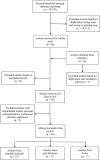A compilation of national plans, policies and government actions for rare diseases in 23 countries
- PMID: 30560012
- PMCID: PMC6290840
- DOI: 10.5582/irdr.2018.01085
A compilation of national plans, policies and government actions for rare diseases in 23 countries
Abstract
Previous studies have focused on the comparison of specific laws among multiple countries and regions; for example, laws related to facilitating treatments with orphan drugs or laws seeking to address the multiple needs of patients with rare diseases. The purpose of this scoping review is to examine and compare published reports on national plans, polices and legislation related to all rare diseases in different countries. We also examine strategies or programs that countries may have for these diseases. Articles were obtained from journals and books published between January 1, 2000, through December 15, 2017. Reports from the grey literature (documents issued by government and private organizations) were included if they were available on the internet. The databases used were Google and Google Scholar, PubMed, and the websites of Orphanet and the National Organization for Rare Disorders (NORD). We obtained information on 23 countries. Among these countries, the way in which rare diseases were defined varied from having similar definitions to no definition. Multinational programs supported by common or similar laws are likely to have a greater impact on rare diseases than single country programs.
Keywords: Rare disease legislation; program; strategy.
Figures
References
-
- Franco P. Orphan drugs: the regulatory environment. Drug Discov Today. 2013; 18:163-172. - PubMed
-
- van Weely S, Leufkens HGM. World Health Organization. Update on 2004 Background Paper, BP 6.19 Rare Diseases http://www.who.int/medicines/areas/priority_medicines/BP6_19Rare.pdf (accessed July 27, 2018).
-
- Eurordis. About Rare Diseases. https://www.eurordis.org/about-rare-diseases (accessed July 27, 2018).
-
- Forman J, Taruscio D, Llera VA, Barrera LA, Coté TR, Edfjäll C, Gavhed D, Haffner ME, Nishimura Y, Posada M, Tambuyzer E, Groft SC, Henter JI; International Conference for Rare Diseases and Orphan Drugs (ICORD). The need for worldwide policy and action plans for rare diseases. Acta Paediatr. 2012; 101:805-807. - PMC - PubMed
Publication types
LinkOut - more resources
Full Text Sources


